-
EngineTurbo 2.5L I4
-
Power250 HP / 310 LB-FT
-
Transmission6-Speed Automatic
-
0-60 Time7.3 Seconds (est.)
-
DrivetrainAll-Wheel Drive
-
Engine PlacementFront
-
Curb Weight4,400 LBS (est.)
-
Seating2+3+2
-
MPG23 City / 30 HWY (est.)
Full disclosure: Our test of the camouflaged CX-9 prototype you see here was short, and while we were able to get a good handle on the CX-9's basic driving dynamics, it'll take more than a 30-mile session around the outskirts of LA to uncover the finer details. What's more, these vehicles are not production ready. In fact, according to our handlers at Mazda, the CUV we tested was actually at the stage before pre-production – so basically, a pre-pre-production car. That said, all the details about the engine, transmission, suspension, and steering are "largely final."
As you can see in the gallery, the cars we tested were heavily camouflaged both inside and out. As for styling, we love it – see the undisguised pictures from the LA show for more views. And as for inside, we can say leather seats of our Grand Touring model were comfortable and supportive, and the smallish steering wheel felt natural in the hand. Even in pre-pre-production state, the CX-9 was impressively quiet. An extra 53 pounds of under-floor sound deadening, thicker windows, and active noise cancellation all contribute to what Mazda claims will be "among the quietest vehicles in its class." It's worth noting that the good sounds, like the throaty, whooshy noises of the turbocharged engine, found their way into the cabin just fine.
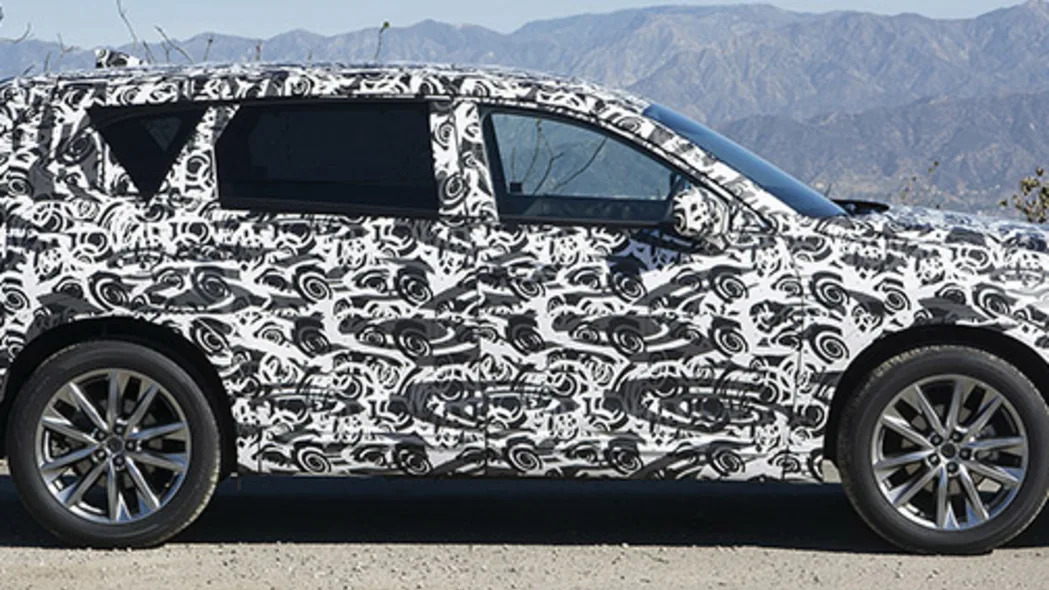
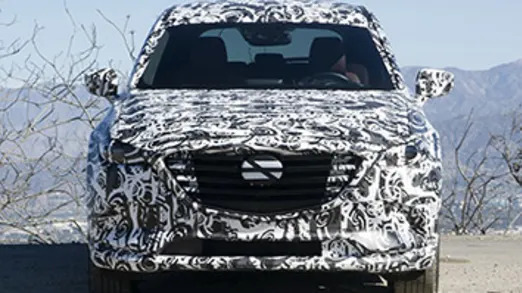
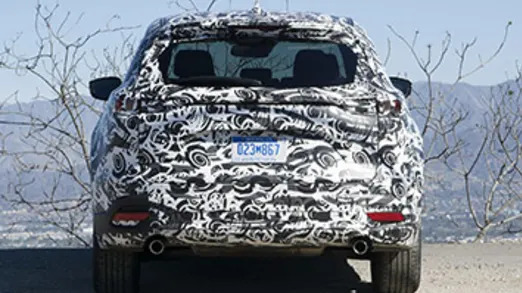
The 2.5-liter, turbocharged four-cylinder engine – Mazda's first force-induced Skyactiv engine – is an excellent piece. It uses a variable geometry turbocharger, which the company calls a Dynamic Pressure Turbo. Here's how Mazda explains it: Imagine a normal garden hose. Put your thumb over the nozzle, and the force of the water increases dramatically. That's the DPT at low rpms. It features three small exhaust ports to direct exhaust gases into the turbo, making for 17.4 quick-spooling PSI at low rpms. As the revs climb, a flow control valve opens up, redirecting the gases to a trio of larger ports – removing your thumb from the hose, if you will – and keeping the boost up.The 2.5-liter, turbocharged four-cylinder engine – Mazda's first force-induced Skyactiv engine – is an excellent piece.
Mazda also fit a four-three-one "pulse converter" exhaust manifold that takes advantage of something called the ejector effect. This setup means that the outer cylinders get their own exhaust ports, while the inner cylinders share a port. That means exhaust gases are always drawn from adjacent ports, allowing the ejector effect to kick in. To understand this effect, imagine an airbrush. Air spews out of the gun, creating a low-pressure effect at the tip, which then sucks paint out of a reservoir. The air and paint mix in the air, and voila, bad spray tans and old-school photo manipulation. In the case of the CX-9, though, the ejector effect helps keep turbocharged boost up by "scavenging" leftover exhaust gases from compressed cylinders.
These systems play well to Mazda's philosophy for the Skyactiv turbo, which aims to produce "real-world" power. That's why you get 310 pound-feet of torque at just 2,000 rpm, while the bulk of the twist remains available at engine speeds up to 4,000 rpm. While this means power does fall off rather precipitously at high rpm, Mazda says most CX-9 customers simply aren't going to be working their engines that hard. In its research, Mazda paced three-row CUV drivers as they ran about their daily errands, and they noticed that most drivers never exceeded 3,000 or 4,000 rpm.
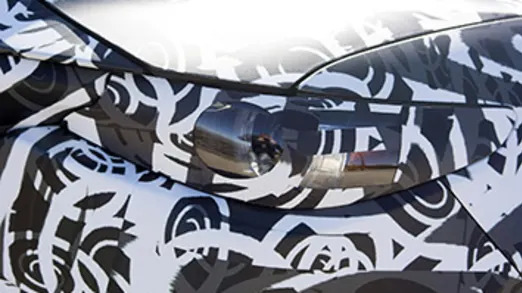
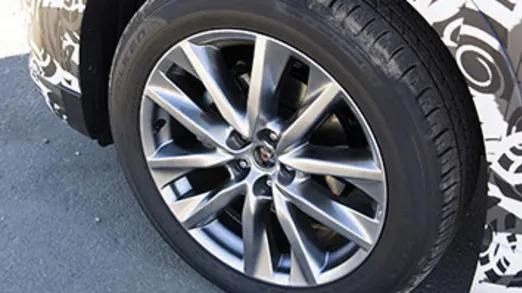
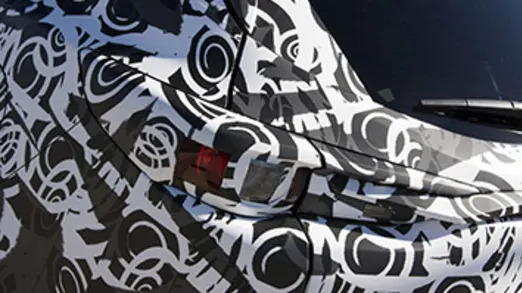
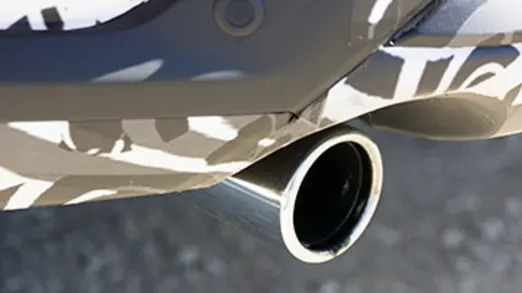
The result of all this work is awesome. While we fancy ourselves as heavy-footed drivers, there simply wasn't a need in the CX-9. Power is abundant off the line. The 2.5-liter had no issue setting us back in our seat and making for breezy, effortless passes along southern California's freeways. On the twistier sections of Mulholland Drive, this low-end torque paired nicely with the lag-free turbo to fling the big CUV about. You notice the high-end power dropoff when you're really driving spiritedly, but given the CX-9's target customer, we don't see that being a problem in the real world.Mazda wouldn't give us estimates, but we'd wager that 30 mpg highway is within reach.
Another neat part of the 2.5-liter engine is the cooled exhaust gas recirculation system, which helps with efficiency. As the name suggests, the cooled EGR chills the exhaust gases in the turbo, reduces the need for fuel enrichment, and contributes to a 10.5:1 compression ratio. That should help the Skyactiv turbo deliver a significant fuel economy improvement over the old 3.7-liter V6, which turned out a paltry 17 miles per gallon city and 24 mpg highway. Mazda wouldn't give us estimates, but we'd wager that 30 mpg highway is within reach.
Speaking of the V6, a few readers asked why Mazda didn't just go that route. Simply put, it's cheaper to add a turbocharger and an intercooler to the existing 2.5-liter four-cylinder than it is to add all the Skyactiv engine tech to a brand-new V6. Besides, even with the Skyactiv tech, Mazda said the V6 would've had a 13:1 compression ratio, more mechanical friction, and greater pumping losses than the 2.5T. As is the trend with many turbo engines these days, downsizing is a great solution – Mazda sees the 2.5-liter as a genuine V6 replacement.
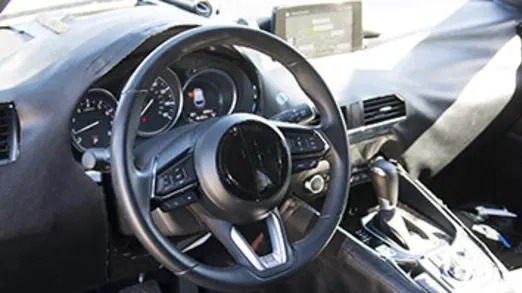
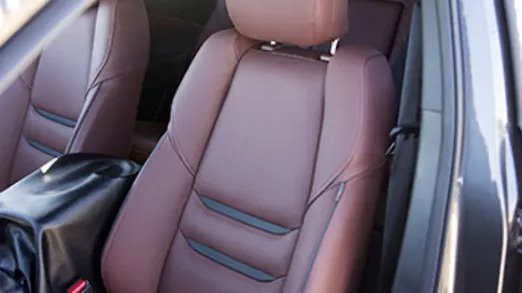
Other readers pointed out that you only get the full 250 horsepower when running on 93-octane fuel; driving with 87-octane results in 227 hp. It's true, and honestly, most customers won't care. In fact, our drive took place on regular-octane fuel, and no one told us until we finished the test. At no point did we think, "You know, this thing could really use an extra 23 hp." Besides, the all-important 310 lb-ft of torque is there regardless of fuel choice.Left on its own, the six-speed executed snappy upshifts; downshifts arrive just as you need them.
Getting away from the engine, the CX-9 is an amalgamation of a bunch of well-received items. The six-speed automatic is from the Mazda6 (which uses the naturally aspirated 2.5-liter Skyactiv engine), and was a solid, trustworthy companion during our test. Left on its own, the six-speed executed snappy upshifts; downshifts arrive just as you need them. The CX-9 doesn't have paddle shifters, but it performed so flawlessly – especially in Sport mode – that we never missed them. The transmission held gears when charging hard and even when lifting off for a turn. During highway cruising and energetic runs, the transmission worked beautifully.
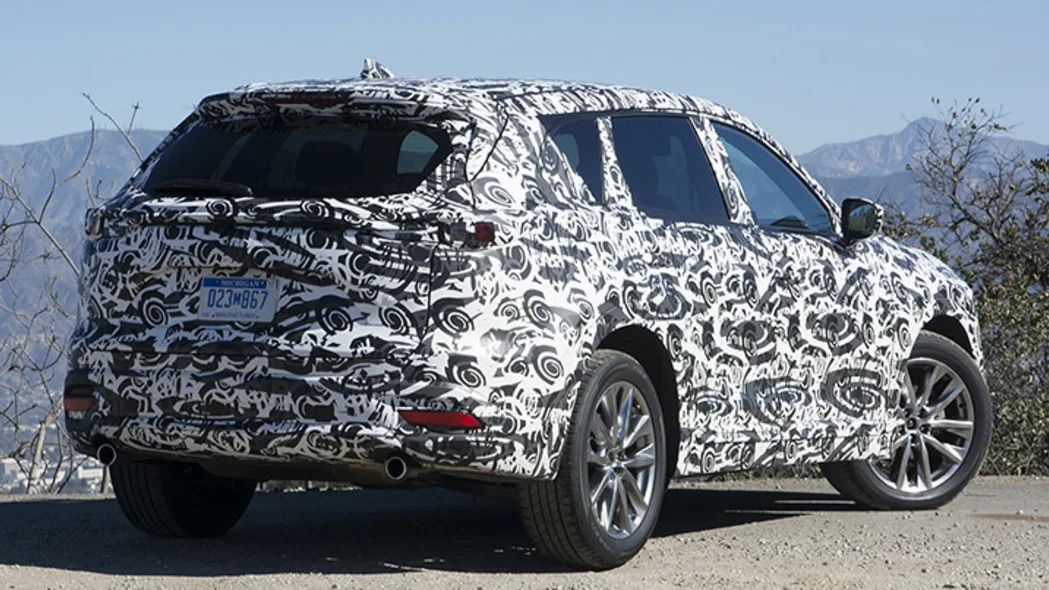
Because it rides on the same Skyactiv chassis architecture as the Mazda6 and CX-5, the CX-9 uses the same suspension arrangement, with MacPherson struts up front and a multilink setup in back. Even with the extra weight – Mazda hasn't published an official spec, but we estimate around 4,100 to 4,400 pounds – the CX-9 should be the standard of the segment in terms of handling. Our tester was genuinely fun to drive, far better than a Ford Explorer, Nissan Pathfinder, or similarly ponderous CUV. Turn-in was sharp and the roll progressive, though the steering did feel a bit isolated on center. Steering weight builds nicely, and overall feedback is fine, but again, we need more time behind the wheel of the finished product before we make a verdict.The 2017 CX-9 introduces a driver-focused element to a segment filled with staid, uninteresting models.
The 2017 Mazda CX-9 does to the three-row CUV segment what the original model did way back in 2006 – it introduces a driver-focused element to a segment filled with staid, uninteresting models. More than that, though, it signals an extension of Mazda's increasingly impressive streak of offering competent driver's cars in mainstream segments. The new CX-9 hits dealers in the spring of 2016. You can look for a comprehensive first drive around then.









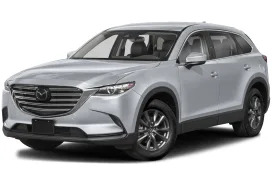
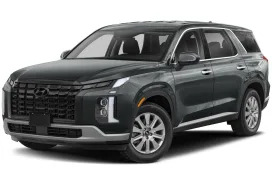
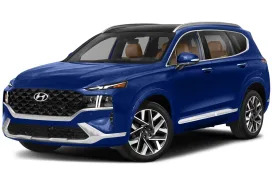

Sign in to post
Please sign in to leave a comment.
Continue